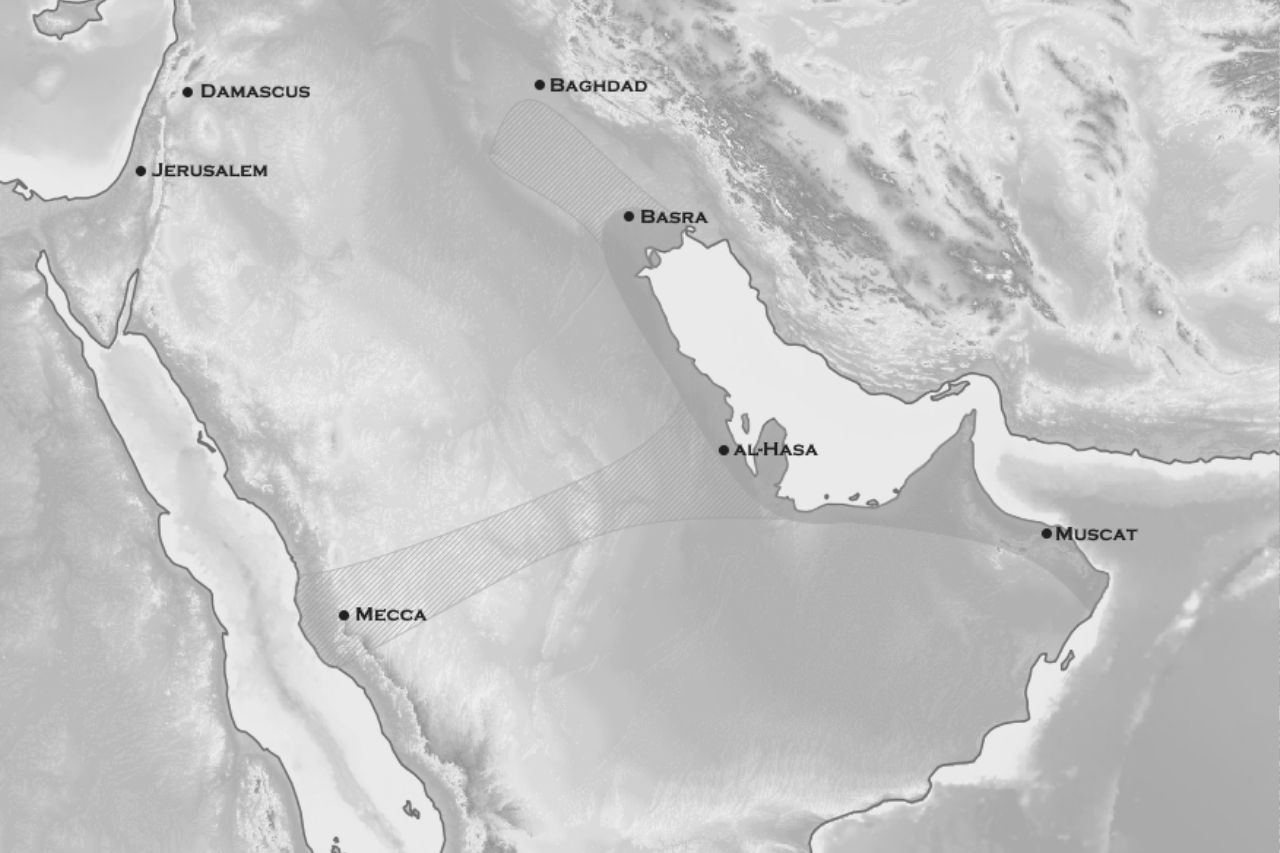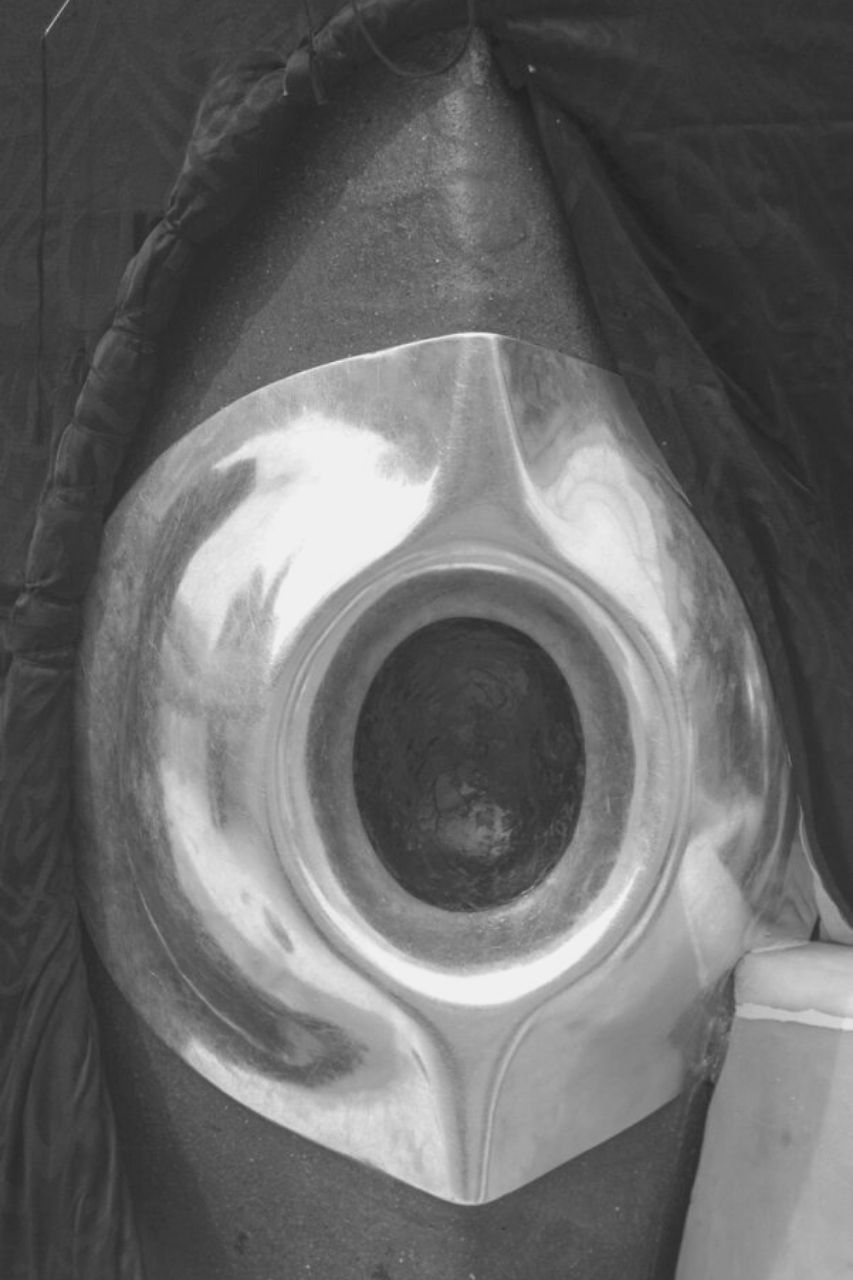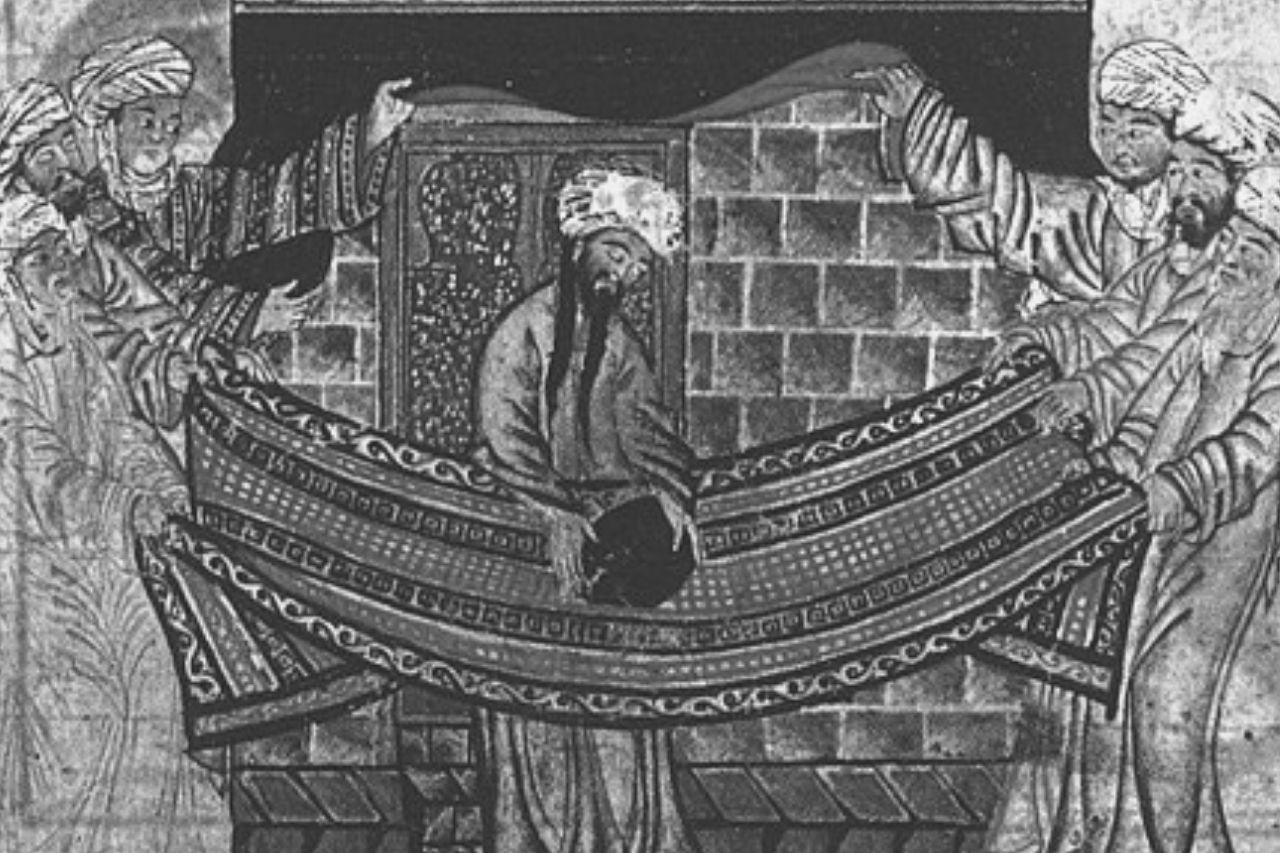Qarmatians: Origins, History & Controversies
The Qarmatians were a sect in Shia Islam whose actions sent shockwaves in the Islamic world after the sacrilege they committed in Mecca. The sect’s visions and ideals focused on creating a utopian society. This article explains this complex Muslim movement and the imprint they left in Islamic history.
Who Were The Qarmatians?
Qarmatians were members of a Shia Muslim movement, which rejects the Fatimid caliph Ubayd Allah’s claim to the Imamate. The Qarmatian movement flourished in Iraq, Yemen, and Bahrain in the 9th, 10th, and 11th centuries.
There is little information about the Qarmatians. However, some believed the group started in southern Iraq during the Abbasid caliphate’s reign (750–1258 A.D.). They were initially part of the general Ismaili movement, a branch of Imamate Shiism.
The Qarmatians were extremist offshoots of the Shia subsect Isma’ilism that aimed to subvert Sunni Islam. They opposed many of Prophet Muhammad‘s teachings and encouraged social equality for nomads, townspeople, and peasants.
Qarmatians derived their name from Hamdan Qarmat, who led the Southern Iraqi sect in the second half of the 9th century. The sect gained notoriety for its Syrian and Iraqi insurrections. The most famous figures in Qarmatian history are the Bahraini leaders Abū Saʿīd al-Jannābī and his son and successor, Abū Ṭāhir Sulaymān. They invaded Iraq multiple times and, in 930 A.D., sacked Mecca, leaving with the Black Stone of Mecca.
The movement believed that the sixth Shiite Imam, Jafa Al-Sadiq, designated his son Ismail as Imam. This is different from other Shiite sects, the Twelvers or Ithnaasharis, who believed that the Imamate chose Muza Al-Kazeem.
From Ismail, they believed that the Imamate passed to his son Mohammad al-Maktum. Upon his death, the sect split into two groups. One became the movement’s forerunner led by Ubayd-Allah Mahdi, founder of the Fatimid caliphate. He publicly claimed the Imamate of the Ismailis for himself and his ancestors.
The second group refused to acknowledge the death of Mohammad al-Maktum. This sect is thought to be the predecessor of the Qarmatians. Al-Markum was expected to reappear and fill the earth with justice.
The Qarmatians were overthrown in 1078 by local Sunni tribes, but their influence continued in Bahrain after their diminishment. From the 13th century, Imami, Shiʿism spread in Al-Ḥasā and Bahrain. At the same time, the Shiʿi Sevener Jarwanid dynasty held political power until around 1450.
Hamdan Qarmat: Founder of the Qarmatians
Hamdan Qarmat b. al-As’at was the founder of the Ismaili movement in Iraq. Born in 874 A.D., he was born in a small village east of Kufa. He was working as a carter when he was converted to by the Ismaili da’i Husayn Ahwaz.
After the death or departure of Ahwaz, he became the organizer of the Ismaili movement in the district of Sawad, alongside his chief propagandist and brother-in-law Abdan. Hamdan and ‘Abdan trained da’is for missions abroad and appointment throughout the districts of the Sawad.
Many scholars believe it to have been the same as the teachings of Salamia and the writings of al-Nawbakhti and Ibn Babawayh. They foretold the impending return of the seventh Imam, Muhammad ibn Isma’il, and thus a new era of justice.
The Mahdi was expected to proclaim a new law, superseding Islam and revealing the religion’s inner truths. Before his return, only those initiated into the doctrine could access it. Because of these beliefs, Qarmatians often abandoned traditional Islamic laws and rituals. Because of modern Islamic source’s hostility towards Qarmatians, there is a lack of trustworthy sources on Qarmat’s doctrines.
Black Stone of Mecca: What It Symbolizes
The Black Stone of Mecca is a Muslim relic that, according to Islamic tradition, dates back to Adam and Eve’s time. It is considered the Eastern cornerstone of the Kaaba, the ancient and sacred stone building towards which Muslims pray. It is also known as Al Hajaru Al Aswad and popularly called the Hajar Aswad.
The dark rock is the center of the Grand Mosque in Mecca. The Kaaba stone has been polished smooth by the hands of millions of pilgrims over the years. The Black Stone of Mecca has been broken into fragments. It is now cemented into a silver frame on the side of Kaaba.
The stone is roughly 12 inches in diameter and 5 feet tall. Many pilgrims try to kiss the Black Stone, emulating the kiss that it received from the Prophet Muhammad. Some believe Ibrahim and his son Ismail found the stone.
The Black Stone of Mecca has been repeatedly desecrated and damaged over the years. Stories say it was struck and smashed into pieces during the Umayyad Caliphate’s siege of Mecca in 683 A.D. The fragments were rejoined by the Mecca-based caliphate leader, Abd Allah ibn al-Zubayr, using a silver ligament.
In January 930 A.D., the Qarmatians stole the sacred stone and hid it in their Hajar base. Historians believed that their ruler, Abu Tahir al-Jannabi, set the Black Stone up in his mosque, the Masjid al-Dirar, to redirect the hajj (pilgrimage) away from Mecca.
However, this attempt failed because pilgrims continued to visit the original spot of the Islam Black Stone. The Stone was returned in 952 A.D. It was held for ransom by the Qarmatians.
After paying a large sum, it was wrapped in a sack and thrown into the Friday Mosque of Kufa. It came with a note stating, “By command we took it, and by command, we have brought it back.” Once returned and now broken into seven pieces, it was embedded into a silver frame to ensure it stayed safe.
In the 11th century, a man who the Fatimid caliph allegedly sent al-Hakim bi-Amr Allah attempted to smash the Black Stone. He failed to cause any significant damage and was killed on the spot.
Qarmatian Revolution
A change of leadership in 899 A.D. triggered the Qarmatian revolution. The minority of Isma’ili’s, whose leader had taken control of the Salamiyah center (now in Syria), claimed that Imam Muḥammad had died. The new leader in Salamiyah was his descendant, who came out of hiding.
Qarmaṭ and his brother-in-law Abdan opposed these teachings and broke apart with the Salamiyids. When ‘Abdan was assassinated, Qarmat went into hiding and repented. Qarmaṭ would later become a missionary of the new Imam, Abdullah al-Mahdi Billah, who founded the North African Fatimid Caliphate in 909.
This dissident group continued to call themselves Qarmatis. Their stronghold was in Bahrain and took over Eastern Arabia and the islands that now form modern-day Bahrain. The Qarmaṭians captured Bahrain’s capital Hajr and al-Hasa in 899 A.D. This then became the capital of the Qarmatian Republic.
The Qarmatian revolution causes a century of terror in Kufa, pillaging and raiding pilgrim routes across the Arabian Peninsula. The ambush of Mecca, which led to the taking of the Black Stone, led to the death of 20,000 pilgrims.
The Qarmatian revolution and description shocked and scared the Muslim world. In the 10th century, the Qarmatian sect was the most potent force in the Middle East and the Persian Gulf. They controlled the coast of Oman, collecting praise from the Baghdadi caliph.
Qarmatian Republic
Qarmatians were initially self-proclaimed Ismailis from the Khuzestan region of Persia and around the Kufa region in Iraq. They were break-away radicals from the Fatimid dynasty. In around 899 AD, the Qarmatian revolution started in Eastern Arabia, now the Bahrain region.
The leader, Abu Sa’id al-Hasan al-Janabi, had the goal to create a Utopian society based on reason and equality. The state was governed by a council of six with a chief who was a first among equals. All the property in this community would be evenly distributed.
The Qarmatian Republic was organized as an esoteric society, but all activities were public. Any new members had to undergo an initiation ceremony. They all shared the belief that the world repeated itself in a cycle, events replaying multiple times. Their Bahrain state was organized with strong egalitarian principles, evolving into a religious republic-like structure in the 11th century.
The land the Qarmatians ruled over was extraordinarily wealthy and was primarily built off slave labor. The republics’ concern for the welfare of the community and consequential social order gained admiration. They undertook experiments of communal property ownership and pooling resources.
Scholars recounted that a mass of Ethiopian slaves cultivated the lands. Qarmatians used the services of these slaves to cultivate rich agricultural lands. Qarmatian territories contained vast fruit, and grain estates, all income from these estates went to the Qarmatian community. The revenues from the customs duties imposed on all ships passing through the Persian Gulf and the island of Owal were distributed amongst Abu Said Al-Jannabi’s descendants.
Inhabitants paid no taxes. Citizens in debt could obtain an interest-free loan, and token lead money was used for transactions. Any new craftsmen arriving were given a start-up loan to help them set up in the republic. Repairs of private properties and mills were paid for by the state, while grain was ground for free in the state mills.
These factors brought on economic prosperity and permitted the financing of large military disbursements and raiding campaigns. Revenues from taxes raided by the state outside the Qarmatian community, protection fees paid for by pilgrim caravans, and war booties were allotted to various groups. A ruling council would allocate revenues following a fixed ratio after setting one-fifth aside for the Mahdi.
Abu Tahir: Warlord of the Qarmatian State
Abu Tahir Sulayman al-Jannabi was an Iranian warlord and the ruler of the Qarmatian state in Bahrain. Under his rule, the state-led the 930 A.D. sacking of Mecca.
He was the younger son of Abi Said al-Jannabi, the founder of the Qarmatian state. He gained power in 923 A.D., after the ousting of his brother Abu’l-Qasim Sa’id. He immediately expanded the state in 923 A.D., raising Basra and Kufa. He defeated the Abbasid army, threatening Baghdad’s Abbasid capital in 928 before pillaging most of Iraq.
In 930 A.D., Tahir led the Qarmatians’ most notorious attack, pillaging Mecca and desecrating Islam’s most sacred sites. After being unable to gain entry to the city, he called upon all Muslims’ rights to enter the city. He promised he would come in peace, but he set about massacring pilgrims once inside the city walls.
Conclusion
The Qarmatians are an early example of a communistic mutual benefit society. This endured for many generations, becoming a powerful and economically prosperous sect. Despite their utopic republic, Qarmatians are associated with the sacrilege they committed in Mecca. To summarize:
Qarmatians are members of a Shia Muslim movement.
The Qarmatian movement flourished in Iraq, Yemen, and Bahrain in the 9th, 10th, and 11th centuries.
Qarmatians take their name from Hamdan Qarmat.
They believed that the sixth Shiite Imam, Jafa Al-Sadiq, designated his son Ismail as Imam.
In January 930, the sacred stone was stolen by the Qarmatians and was return in 953.
Abu Sa’id al-Hasan al-Janabi had the goal to create a Utopian society based on reason and equality.
The Qarmatian republic was a utopic equal place where interest-free loans were given out. The state didn’t tax inhabitants.













